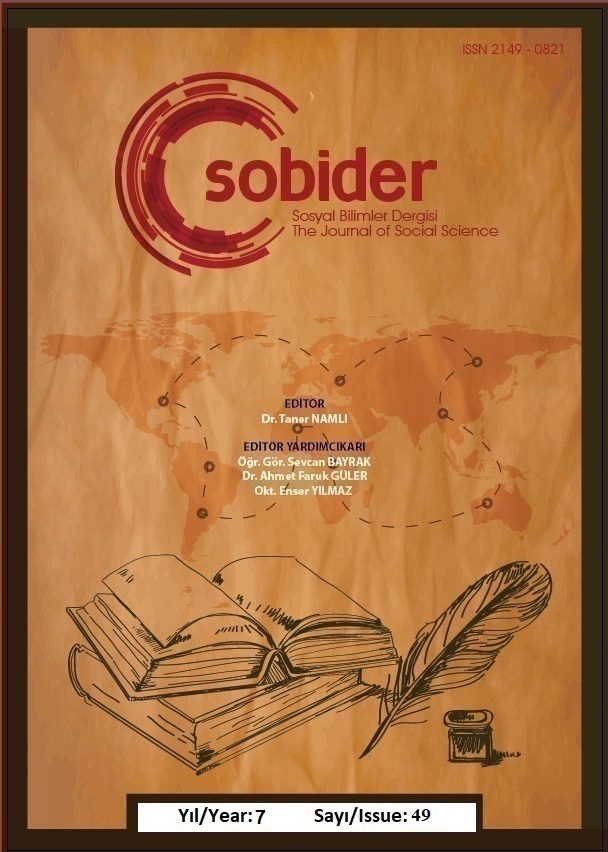DEDE KORKUT HİKÂYELERİNİN SİNEMAYA AKTARIMINDA GELENEĞİN İCADI, DİLİN ADAPTASYONU VE KURGUNUN YENİDEN YARATIMI: “SALUR KAZAN: ZORAKİ KAHRAMAN” FİLMİ ÖRNEĞİ
Author :
Abstract
Kültür, toplumların milletleşme ve bir arada yaşayabilme süreçlerinin temelinde yer alan, yine insanlar tarafından tarihî ve içtimâî süreçlerin sonucu olarak ortaya konan, toplumun bütün hususiyet ve kabullerini belirleyen maddî ve manevî değerler silsilesidir. Bu yönüyle kültürel unsurlar, kaynağını toplumun asırlar boyu taşıdığı birikimler, teamüller ve meydana getirdiği maddi-manevi ürünlerden almaktadır. Mit, destan, efsane, masal gibi sözlü anlatımlar, kültürel birikimlerin yansıtılmasına ve nesilden nesile aktarılmasına büyük katkı sağlamaktadır. Tarihî süreçlerden geçerken sırasıyla şifâhî yolla aktarılan bu sözlü kültür unsurları, daha sonra yazının icadıyla kayıt altına alınma imkânına kavuşmuş ve teknolojik gelişmelerle beraber elektronik kültür ortamına taşınmıştır. Dede Korkut Hikâyeleri, sözlü gelenekten yazıya aktarılmış, Türk kültürünün istisnasız en önemli anlatılarından biridir. Bu yönüyle, Türk kültürünün neredeyse bütün yapıtaşlarını barındırmaktadır. Yazıya geçirildiği tarihten bugüne kadar radyo programları, tiyatro, öykü, roman, karikatür gibi birçok sanatsal ürüne metinsel bağlamda kaynaklık etmiş; zamanla çizgi film ve sinema ürünlerine de konu olmuştur. Doğrudan yansıtma, edebî dönüştürüm, yeniden yaratım gibi yollarla kültürel aktarımda önemli bir yer işgal eden Dede Korkut Hikâyeleri, son zamanlarda, farklı sinema ve yazım metotlarıyla, muhataplara sunulmaktadır. Senaryosu ve yönetmenliği Burak Aksak’a ait olan “Salur Kazan: Zoraki Kahraman (2017)” filmi, “Salur Kazan’ın Evinin Yağmalandığı Boy”un bugüne kadar üretilen örneklerden farklı olacak şekilde, Dede Korkut boylarından birinin yeni bir üslup ve teknik anlayışla sinemaya aktarılma örneğidir. Filmde, anakroni, yapı-çözüm, yapı-bozum, destan dilinin günümüze intibakı/adaptasyonu, yeniden kurgulanması ve yaratılması gibi farklı tekniklerin kullanılması, bahsi geçen filmi, diğer örneklerden farklı bir noktaya taşımaktadır. Bu çalışmada, “Salur Kazan: Zoraki Kahraman (2017)” filmi, geleneğin icadı, dilin adaptasyonu ve kurgunun yeniden yaratımı” bağlamında incelenecektir. Boydaki anlatının dil ve metin hususiyeti bakımından filme aktarılış şekli irdelenerek, yazılı kültür ortamından elektronik kültür ortamına geçen bu unsurların, muhtevayı iletme, muhataplarca anlaşılma gibi hususlarda ne derece etkili olduğu tartışılacaktır.
Keywords
Abstract
Culture is a set of values that are based on the processes of nationalization and the coexistence of societies. Culture is created by people as a result of historical and social processes and is the sum of material and spiritual elements that determine all the characteristics and acceptances of society. In this respect, cultural elements derive their source from the experiences, practices and material-spiritual products that society has brought about for centuries. Oral narratives such as myth, saga, legend and fairy tale contribute greatly to the reflection of cultural accumulation and its transmission from generation to generation. These elements of oral culture, which are passed through the historical processes in order to be transferred in a literal way, were later recorded with the invention of writing and moved to "electronic culture environment" with technological developments. The stories of Dede Korkut are one of the most important texts of Turkish culture without exception, transferred from oral tradition to writing. In this respect, it contains almost all the building blocks of Turkish culture. From the date it was written to date, it has been the source of many artistic products such as radio programs, Theatre, short stories, novels, cartoons, cartoons and movies. Dede Korkut stories, which occupy an important place in cultural transfer through direct reflection, literary transformation and re-creation, have recently been presented to the interlocutors with different cinema and writing methods. The film “Salur Kazan: Zoraki Kahraman (2017)”, which is written and directed by Burak Aksak, is an example of one of the Dede Korkut stories being transferred to cinema with a new style and technical understanding, in a way that differs from the examples produced to date of “The Story of The House of Salur Kazan Was Looted”. In the film, the use of different techniques such as anachronism, structure-solution, structure-distortion, adaptation/adaptation of epic language to the present day, re-editing and creation takes the film to a different point than the other examples. In this work, the film “Salur Kazan: Zoraki Kahraman (2017)” will be examined in the context of the invention of tradition, the adaptation of language and the re-creation of fiction”. In terms of language and text characteristics of the narrative, the way it is transferred to the film will be examined and it will be discussed how effective these elements are in matters such as the transmission of content and understanding by the interlocutors.
Keywords
- Aça, M. ve Sağlam, M. (2019). Evlilik Ve Mülkiyet Temelinde İcat Edilmiş Bir Halk Hukuku Uygulaması. Motif Akademi Halkbilimi Dergisi, 12(27), 501-515
- Adorno, T. W. (2011). Kültür Endüstrisi (Çev.: Nihat ünler, Mustafa Tüzel, Elçin Gen). İstanbul: İletişim Yayınları.
- Aksak, B. (2017). Salur Kazan Zoraki Kahraman (Sen.: Burak Aksak. Oyun.: Erdal Tosun, Mahir İpek, Devrim Yakut, Onur Atilla ve diğer.), BKM.
- Arnheim, R. (2012).Sanat Olarak Sinema (Çev.: Rabia Ünal). Ankara: Öteki Yayınevi.
- Baudillard, J. (2013). Tüketim Toplumu (Çev.: Hazal Deliceçaylı, Ferda Keskin). İstanbul: Ayrıntı Yayınları.
- Genette, G. (2011). Anlatının Söylemi: Yöntem Hakkında Bir Deneme (Çev.: F. Burak Aydar), İstanbul: Boğaziçi Üniversitesi Yayınevi.
- Guliyev, H. (2018). Azerbaycan Atasözlerinin İnternet Ortamında Değişim Süreci: Parodik Yorumlama. 5. Uluslararası Geleneksel ve Yöresel Değerler Sempozyumu (26-28 Ekim 2020), Afyonkarahisar, Türkiye.
- Hobsbawm, E. ve Ranger, T. (2006). Geleneğin İcadı (Çev.: M. Murat Şahin). İstanbul: Agora Kitaplığı.
- Kızıldağ, H. (2016). Anakronik Bir Kahraman. Keloğlan Aramızda”. JASSS, 53, 447-458.
- ----------------- (2019a). "Mevlevî Menkıbeleri’nde Kozmik Unsurlar." Uluslararası Halkbilimi Araştırmaları Dergisi 1.2: 90-101.
- ----------------- (2019b). Geleneğin İcadı Bağlamında Nasreddın Hoca Karıkatürlerı. Turkish Studies Language and Literature, 14(4): 1971-1988.
- Said, E. W. (2016). Kültür ve Emperyalizm (Çev.: Necmiye Alpay). İstanbul: Hil Yayın.
- Tulum, M. ve Tulum, M. M. (2016). Dede Korkut Oğuznameler Oğuz Beylerinin Hikâyeleri. Ankara: Atatürk Kültür Merkezi Yayınları.
- Williams, R. (1993). Kültür (Çev.: Suavi Aydın). Ankara: İmge Kitabevi Yayınları.
- Morreal, J. (1997). Gülmeyi Ciddiye Almak (Çev.: Kubilay Aysevener ve Şenay Soyer). İstanbul: İris Yayıncılık.





